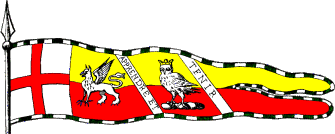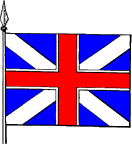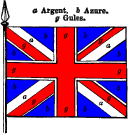Flag
Flag
Flag, (fr. drapeau): the flag, like the shield, was ornamented with heraldic devices, &c.; and further than this, it appears itself sometimes as a charge: a few notes on the names of flags are therefore appended. As already pointed out, a distinction has been made between a banner which is a square flag, and a flag proper, though it is rather a theoretical than a practical one.
Azure, a chevron between three flags displayed argent--DRUMSON.
Argent, a saltire between four laurel leaves vert, on a chief embattled azure two French flags in saltire, surmounted by a sword erect all proper; over the sword Bourbon in gold letters--Sir Henry KEATING, Justice of the Common Pleas, 1859.
Argent, a lymphad with sail furled on a sea in base proper, at the poop a flag flying towards the bow argent fimbriated vert, charged with a pomme in fesse, on a chief gules three bezants each charged with a mullet--UTTERSON, Sussex.
The Standard, (fr. estendart), is a long flag, gradually becoming narrower towards the point, which, unless the standard belong to a prince of the blood royal, must be split. The following figure is taken from a pedigree of the WILLOUGHBY family, c. temp. Eliz. It may be described as follows:--
In the chief, the cross of St.George, the remainder being parted per fesse or and gules[the livery colours], divided into three portions by the white scroll containing the motto. In the first the cognizance--a griffin passant argent, armed blue. In the second crest, an owl crowned proper, upon a wreath of the family colours. The fringe green and white, the colours of the royal house of Tudor.

Standard of different dimensions are assigned by heraldic writers to each rank, from an emperor's standard of eleven yards long, down to a baronet's of four yards.
What is now called the Royal Standard, namely a square flag bearing the royal arms, is, properly speaking, a banner, for a standard cannot be square, and ought only to contain crests, badges, mottoes, and ornaments, and not the arms, but custom has sanctioned the name. The royal standards, however, were anciently of the true form, though the devices have varied; that of Edw. III. may be described as follows:--
In the chief the cross of S.George, the remainder party per fesse azure and gules, and divided into three portions by a white scroll, bearing--DIEU ET MON DROIT.
In the first, a Lion of England between in chief a coronet of crosses patés and fleur-de-lys between two clouds irradiated proper; in base, a cloud between two coronets. In the second, in chief a coronet; in base, an irradiated cloud. The third, quarterly 1 and 4, an irradiated cloud, 2 and 3 a coronet.
Standards are sometimes named in coats of arms.
Gules, on a standard argent, fringed or, in saltire, with a broken spear of the second, a cross of the first--SMYTH, Scotland[granted 1765.]
Argent, three standards(another vanes) sable in an orle gules--VYRNEY.
The Union Jack. The national flag of Great Britain and Ireland is also, properly speaking, a banner and not a flag, but as custom has sanctioned the name, it is given here instead of under banner. It was the banner of S.George(argent, a cross gules), to which the banner of S.Andrew(azure, a saltire argent) was united(instead of being quartered according to ancient custom) is pursuance of a royal proclamation dated April 12, 1606. It would then have been blazoned as follows:--

Azure, a saltire argent, surmounted by a cross gules, fimbriated(more accurately edged) of the second.
The white edging was no doubt intended to prevent one colour from being placed upon another, but this precaution was hardly necessary, for the mere contact of the red cross and blue field would have been authorized by numerous precedents. This combination was constituted the national flag of Great Britain by a royal proclamation issued July 28, 1707.

No further change was made until the union with Ireland, Jan. 1, 1801, previous to which instructions were given to combine the banner of S.Patrick(argent, a saltire gules) with the crosses of S.George and S.Andrew. In obedience to these instructions, the present national flag of Great Britain and Ireland was produced, which may perhaps best be blazoned thus(though there is difference of opinion as to the correct manner). It must be drawn with upper quarters of the saltire argent towards the staff, and lower quarters argent away from it.
Azure, the saltires of S.Patrick and S.Andrew quarterly per saltire, counterchanged argent and gules; the latter fimbriated of the second; surmounted by the cross of S.George of the third, fimbriated as the last.
The word Jack is of doubtful origin, possibly some trifling incident may have given the name. Philologists have derived it from the surcoat, charged with a red cross anciently used by the English soldiery, which was once called a jacque(whence the word jacket): but it is doubtful whether the name Union Jack ever appears before the name jacque had quite gone out of use. Others suggest that the name of Jacques was given by the French in allusion to King JAMES, in whose reign the union took place. But these are more guesses.
The Gonfanon is said to differ from a banner in this respect that instead of being square and fastened to a transverse bar, the gonfanon, though of the same figure, was fixed in a frame made to turn like a modern ship's vane, with two or three streamers, or tails.
Guidon, or(fr. Guidhomme), is a flag resembling the standard in form, but less by one third, and generally ending in a point. An ancient was a name given to the guidon carried at funerals.
Quarterly sable and argent, the first quarter occupied by a lion rampant of the second, over all a representation of the guidon of the Thirty-first Regiment( .... two laurel leaves saltirewise .... below the Union Jack) in bend sinister--BYNG, Earl and Baron Strafford.
Pennon: a flag resembling the guidon in shape, but only half the size. It is not be charged with arms, but only with crests, heraldic and ornamental devices, and mottos.
La ot meint richa guarnement Meint beau penon en lance mis
Brodé sur sendaus e samis Meint banier deploié.
Roll of Carlaverock, A.D. 1300.
Argent, two lances in saltire sable, pennons gules, surmounted by an esquire's helmet azure--CLINKSCALES.
A kind of pennon seems also to have been called an ancient, but many of these names appear to be loosely used. See Banner.
The Pennant in ships is probably the same. It sometimes ends in a points, more often it is forked. In the former case it is also called a streamer.
Argent, a saltire wavy sable between two human hearts gules in flanks a dexter hand gules holding a cross crosslet azure in chief, and a ship(square rigged) proper with pennants gules in base-John TAYLOR, Orkney.

Pennoncelle, or Pensell: the diminutive of the pennon, supposed to be carried at the end of a lance. As used at funerals, they are very small pointed flags charged with crests and ornaments.
A demi-lion argent issuing from a ducal coronet, and holding a pennoncelle gules charged with a lion passant gardant or, the staff of the last--Crest of BROMLEY, Staff. and Warw.
Pavon: a triangular flag about four or five yards long, tapering from about half a yard in width to a point, the lower side being at a right-angle to the staff.
Banderolle, a narrow but flag or streamer sometimes attached to the staff beneath the flag itself.
Vane, sometimes written wyn, also signifies a little flag.
Please Help!
DrawShield is a Free service supported by its users.

If you can, please help cover the cost of the server, or just buy the team a coffee to say thanks!
 Buy me a coffee
Buy me a coffee


